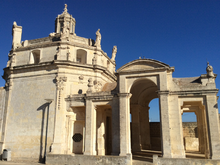Andrea Belli
Andrea Belli | |
|---|---|
| Born | 13 October 1703 |
| Died | 19 October 1772 (aged 69) |
| Nationality | Maltese |
| Occupation(s) | Architect and businessman |
| Notable work | Auberge de Castille |
| Style | Baroque |
| Spouse |
Teresa Gam (m. 1737) |
| Children | Giuseppe Belli |
| Parents |
|
Andrea Belli (13 October 1703 – 19 October 1772) was a Maltese architect and businessman. He designed several Baroque buildings, including Auberge de Castille in Valletta, which is now the Office of the Prime Minister of Malta.
Life and career
He was born in Valletta on 13 October 1703 to the surgeon Giuseppe Belli and his wife Francesca Romano. He spent some time in Venice as a youth, and he later traveled to Austria and Germany.[1]


As an entrepreneur, Belli became a successful businessman by having achieved monopoly from Grand Master Pinto over the export of Maltese limestone and other products to Africa, Asia and Europe.[2]
Belli became an architect, and he designed several buildings in the Baroque style. These include:[1][3]
- Seminary (now the Cathedral Museum), Mdina (1733–42, attributed)
- Augustinian priory, Rabat (1740)
- Auberge de Castille, Valletta (1741–45)
- Bishop's curia, Floriana (1743)
- Centrepiece of Bishop's Palace, Valletta
- Church of Our Lady of Divine Providence, Siġġiewi (1750)
- Palazzo Don Raimondo (now the National Museum of Fine Arts), Valletta (1761–63, attributed)
- St. Philip Neri church, Birgu (attributed)
- Palazzo Bonici, Valletta[4]
- Chapel at Villa Cagliares in Zejtun (attributed)[5]

Auberge de Castille is regarded as his masterpiece.[1]
Belli was also involved in business, and in 1741 he took over the firm of the Manoel Theatre.[1]
Belli married Teresa Gam on 5 June 1737, and they had one son called Giuseppe.[1]
He died on 19 October 1772 at the age of 69.[1]
Further reading
- Bonello, Giovanni (2000). Art in Malta - Discoveries and Recoveries. Fondazzjoni Patrimonju Malti. p. 125-142. ISBN 99909-959-7-4. ISBN 99909-959-8-2.
References
- ^ a b c d e f Schiavone, Michael J. (2009). Dictionary of Maltese Biographies Vol. 1 A-F. Pietà: Pubblikazzjonijiet Indipendenza. p. 192. ISBN 9789993291329.
- ^ Ellul, Michael (2010). "Malta Limestone goes to Europe: Use of Malta Stone outside Malta". In Joseph F. Grima (ed.). 60th anniversary of the Malta Historical Society: a commemoration. Zabbar: Veritas Press. pp. 371–406. ISBN 978-99932-0-942-3. OCLC 779340904. Archived from the original on 25 March 2019.
- ^ Gaul, Simon (2007). Malta, Gozo and Comino. New Holland publishers. p. 325. ISBN 9781860113659.
- ^ https://www.timesofmalta.com/articles/view/20080617/opinion/one-world-protecting-the-most-significant-buildings-monuments-and.212939
- ^ Mifsud, Maria (23 November 2008). Restoring old buildings. Times of Malta. Archived from the original on 1 April 2016.
